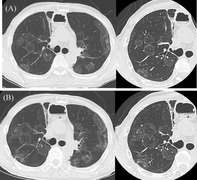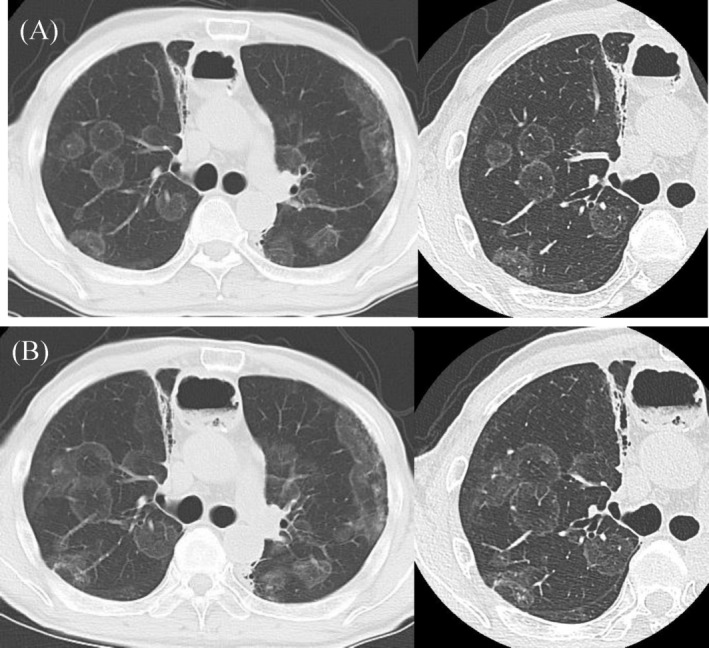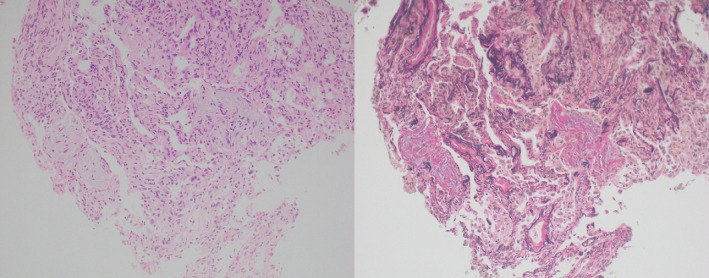Key message
Among immune‐related adverse events, pneumonitis is relatively uncommon, and nivolumab‐related pneumonitis may present with a reversed halo sign.
Keywords: chemotherapy, nivolumab, oesophageal squamous cell carcinoma, organizing pneumonia, reversed halo sign
We report a case of nivolumab‐induced organizing pneumonia with reversed halo sign. Interestingly, the reversed halo sign expanded concentrically.

CLINICAL IMAGE
A 62‐year‐old man with middle and lower oesophageal squamous cell carcinoma underwent esophagectomy in January 2021 (pathological staging: T3N2M0, pStage IIIB). S‐1 was administered for 4 months as adjuvant chemotherapy, after which the patient developed retrotracheal mediastinal lymph node metastases. Chemoradiotherapy with 5‐fluorouracil and cisplatin was administered; however, the metastases persisted. Therefore, nivolumab treatment was initiated in October 2021. Because the patient exhibited symptoms of non‐productive cough, chest computed tomography (CT) was performed in May 2022, which revealed multiple round ground‐glass opacities surrounded by a consolidation rim, known as the reversed halo sign, suggestive of organizing pneumonia (Figure 1A). 1 Two weeks later, chest CT was performed because of worsening cough and revealed concentric expansion of the reversed halo signs (Figure 1B). Bronchoalveolar lavage fluid analysis revealed 44% lymphocytosis with a CD4/CD8 ratio of 0.37; however, no signs of infection or eosinophilia were noted. Histopathological examination of a transbronchial lung biopsy specimen revealed organizing pneumonia (Figure 2). The patient was diagnosed with nivolumab‐induced organizing pneumonia. Treatment with prednisolone led to radiological improvement. Among all immune‐related adverse events, pneumonitis is relatively uncommon 2 and nivolumab‐related pneumonitis may present with a reversed halo sign.
FIGURE 1.

(A) Chest computed tomography (CT) revealed multiple round ground‐glass opacities fringed with consolidation, namely, the “reversed halo signs.” (B) Two weeks later, chest CT revealed concentric expansion of the reversed halo signs.
FIGURE 2.

Transbronchial lung biopsy specimens revealed polypoid granulation tissues and foamy cells in the terminal air spaces, mild alveolar septal infiltration of lymphoid cells, and basic alveolar structures, which is consistent with an organizing pneumonia pattern.
AUTHOR CONTRIBUTIONS
Hirokazu Tokuyasu conceived and drafted the manuscript. Yoshitoshi Sato, Yuriko Sueda, Hiromitsu Sakai, and Chika Esumi contributed to clinical management of the patient. Akira Yamasaki revised the manuscript for the intellectual content. All the authors contributed to and approved the final version of the manuscript.
CONFLICT OF INTEREST STATEMENT
None declared.
ETHICS STATEMENT
The authors declare that appropriate written informed consent was obtained for the publication of this manuscript and the accompanying images. Consent for the publication of this case report was obtained from the patient.
ACKNOWLEDGMENTS
The authors thank Editage for their assistance in English language editing.
Tokuyasu H, Sato Y, Sueda Y, Sakai H, Esumi C, Yamasaki A. Concentrically expanded reversed halo sign caused by nivolumab‐related pneumonia. Respirology Case Reports. 2024;12(5):e01352. 10.1002/rcr2.1352
Associate Editor: Belinda Miller
DATA AVAILABILITY STATEMENT
The data that support the findings of this study are available on request from the corresponding author. The data are not publicly available due to privacy or ethical restrictions.
REFERENCES
- 1. Kim SJ, Lee KS, Ryu YH, Yoon YC, Choe KO, Kim TS, et al. Reversed halo sign on high resolution CT of cryptogenic organizing pneumonia: diagnostic implications. AJR Am J Roentgenol. 2003;180:1251–1254. [DOI] [PubMed] [Google Scholar]
- 2. Nishino M, Globbie‐Hurder A, Hatabu H, Ramaiya NH, Hodi FS. Incidence of programmed cell death 1 inhibitor‐related pneumonitis in patients with advanced cancer: a systematic review and meta‐analysis. JAMA Oncol. 2016;2:1607–1616. [DOI] [PubMed] [Google Scholar]
Associated Data
This section collects any data citations, data availability statements, or supplementary materials included in this article.
Data Availability Statement
The data that support the findings of this study are available on request from the corresponding author. The data are not publicly available due to privacy or ethical restrictions.


